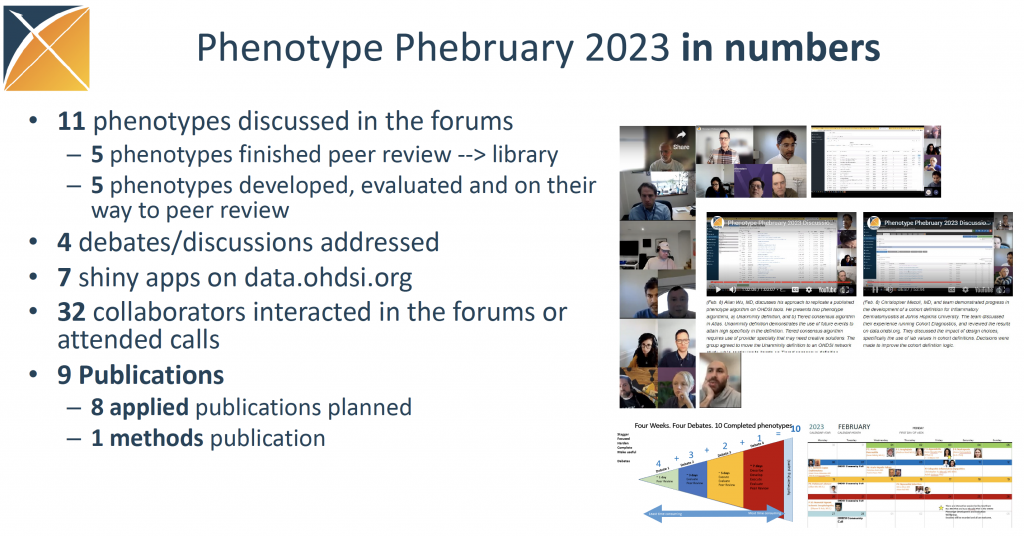- Who We Are
- Updates & News
- Standards
- Software Tools
- Network Studies
- Community Forums
- Education
- New To OHDSI?
- Community Calls
- Past Events
- 2024 India Symposium
- 2024 Europe Symposium
- 2024 Thailand Tutorial
- 2024 Japan Tutorial
- 2024 DevCon
- 2024 Phenotype Phebruary
- 2023 Global Symposium
- 2023 APAC Symposium
- 2023 Europe Symposium
- 2023 SOS Challenge
- 2023 DevCon
- 2023 Phenotype Phebruary
- 2022 Global Symposium
- 2021 Global Symposium
- 2020 Global Symposium
- ALL Past OHDSI Events
- Workgroups
- 2024 ‘Our Journey’ Annual Report
- Current OHDSI Events
- Support & Sponsorship
- CBER Best Seminars
- 2024 Global Symposium
- 2024 APAC Symposium
- Github
- YouTube
- Newsletters
Phenotype Phebruary 2023: How To Join The Effort
“Phenotype Phebruary” was a community-wide initiative to both develop and evaluate phenotypes for health outcomes that could be investigated by the community.
This is the second year of Phenotype Phebruary in the OHDSI community (look back at Year 1 here). It was introduced during the Jan. 31 community call (watch here), and went on throughout the month. This year, the leadership team of Gowtham Rao and Azza Shoaibi helped identify 11 phenotypes that are being investigated throughout the month. Though the month has ended, the work continues. If you would like to join the discussions around any of the phenotypes, please visit the appropriate links below, which will take you to the proper threads on the OHDSI forums.
What Did We Accomplish?

Join Our Community Efforts Around Any Of These Phenotypes
Join Our Community Discussions Around These Phenotype Phebruary Topics
Phenotype Phebruary Videos
(Feb. 28) Azza Shoaibi and Gowtham Rao provide an update on the final week of Phenotype Phebruary. Evan Minty and Khyzer Aziz discussed some specific phenotype work around neonatal hypoxic ischemic encephalopathy, while Azza Shoiabi provided an impressive wrap-up of all the outputs from the month.
(Feb. 21) Azza Shoaibi and Gowtham Rao provide an update on the third week of Phenotype Phebruary. The phenotype discussions that were featured during Week 3 included Parkinson’s disease (Allan Wu) and myocardial infarction (Mirza Khan/Adam Atif), and Mirza Khan joins the discussion to provide an update on myocardial infarction. Khyzer Aziz discusses early work done on the Week 4 phenotype, Neonatal Hypoxic Ischemic Encephalopathy.
(Feb. 14) Azza Shoaibi and Gowtham Rao provide an update on the second week of Phenotype Phebruary. The phenotype discussions that began during Week 2 included systemic lupus erythematous (Joel Swerdel), acute hepatic failure (Christian Reich), and idiopathic inflammatory myopathies (Christopher Mecoli). There was also a discussion about chart review gold standard validation vs innovative methods like PheValuator.
(Feb. 10) Week 2 of Phenotype Phebruary concluded with this OHDSI Phenotype Development and Evaluation workgroup meeting. In this session, the workgroup assigned leads to each phenotype that are part of the OHDSI Phenotype Phebruary 2023, including development of a publication plan for each of the 10 phenotypes. There was also an in-depth look at the work being done on the Inflammatory Dermatomyositis phenotype (around the 36:00 mark).
(Feb. 8) Allan Wu, MD, discusses his approach to replicate a published phenotype algorithm on OHDSI tools. He presents two phenotype algorithms, a) Unanminity definition, and b) Tiered consensus algorithm in Atlas. Unanminity definition demonstrates the use of future events to attain high specificity in the definition. Tiered consensus algorithm requires use of provider specialty that may need creative solutions. The group agreed to move the Unanminity definition to an OHDSI network study, while continuing to iterate on Tiered consensus definition.
(Feb. 8) Christopher Mecoli, MD, and team demonstrated progress in the development of a cohort definition for Inflammatory Dermatomyositis at Johns Hopkins University. The team discussed their experience running Cohort Diagnostics, and reviewed the results on data.ohdsi.org. They discussed the impact of design choices, specifically the use of lab values in cohort definitions. Decisions were made to improve the cohort definition logic.
(Feb. 7) Azza Shoaibi and Gowtham Rao provide an update on the first week of Phenotype Phebruary. The phenotype discussions that began during Week 1 included acute pancreatitis (Evan Minty), anaphylaxis (Andrea Noel), appendicitis (Azza Shoaibi), and neutropenia (Anna Ostropolets).
(Feb. 8) Mirza Khan, MD, discussed the clinical idea of ST elevated Myocardial Infarction and how it is different from other Myocardial infarction. This video demonstrates the translation of the clinical idea into an Atlas Cohort Definition. You can observe how to a) Clarify the clinical idea, b) Develop logic description, c) Structure the logic description into ATLAS cohort definition logic, and d) Develop cohort definitions in Atlas.
(Feb. 4) Andrea Noel, Azza Shoaibi, Gowtham Rao and others joined in a peer review around phenotyping appendicitis.
(Jan. 31) Patrick Ryan and Azza Shoiabi provided an introduction to Phenotype Phebruary with a look at the importance and challenge of phenotyping, some of the open-source tools developed to assist the process, how successful development & evaluation of phenotypes can aid OHDSI research, and how the community can take part in Phenotype Phebruary.
